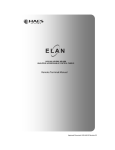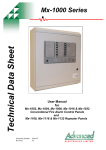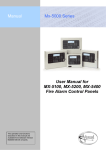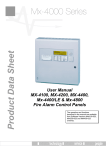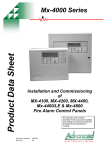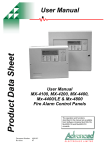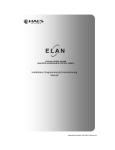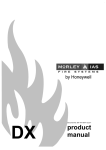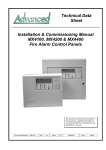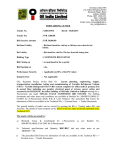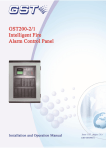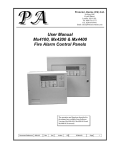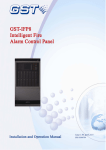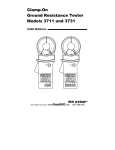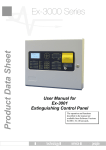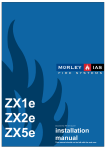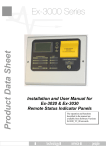Download Manual LifeLine Series Installation, Programming and
Transcript
Manual LifeLine Series Installation, Programming and Operation of PX-100 Lifeline Paging Control Panel The operation and functions described in this manual are available from Software Version Px100-001-01 onwards. Item Specification Details Px-100 Enclosure Steel IP30 RAL7035 Dimensions H x W x D mm 288 x 348 x 78 Weight (excluding batteries) 3.9Kg Temperature -5°C to 40°C Humidity (RH) 95% Max Cable Entries (20mm knockouts) 6x top / 4x bottom / 1x rear AC Supply (ratings marked on label inside panel – see section 3.1 for location) 230V AC +/- 15%, xxA Battery Capacity 2.6Ah (min) 7Ah (max) Charging Current 0.35A nominal Battery support Up to 72 hours (depending on battery and backlight mode) Ripple (Vpkpk) 200mV max (Note: 1V p-p including switching frequency). Max Battery Resistance 1Ω +/1 0.1 Ω Imax(a)/ Imax(b) 2.0A 2.0A Supply Monitoring Serial Data Communcations to main processor Indicates AC condition, battery voltage, charger voltage, charging current and temperature. Display Backlit 124 x 64 graphical LCD LED Indicators 1 Green (Power), 1 Blue (Transmit & 3 Yellow (Fault & Status) Keypad Alpha Numeric Keypad, Navigation Keys Controls 4 Programmable Function Buttons Serial port USB only Transmitter Frequency 459.15MHz, 25KHz channel separation Transmitter power Selectable in defined steps from 25mW to 2.0W As our policy is one of constant product improvement the right is therefore reserved to modify product specifications without prior notice Page 2 of 50 Table of Contents 1 Page INTRODUCTION __________________________________________________________ 6 1.1 Standards ____________________________________________________________ 1.2 Cautions and Warnings__________________________________________________ 1.3 Description ___________________________________________________________ 1.3.1 Px-100 Series _____________________________________________________ 1.4 Installation Approvals ___________________________________________________ 1.4.1 Fire System Installations _____________________________________________ 1.4.2 Wiring Regulations__________________________________________________ 1.4.3 Radio Licence _____________________________________________________ 2 6 6 7 7 7 7 7 7 OPERATION _____________________________________________________________ 8 2.1 Controls and Indications _________________________________________________ 8 2.1.1 Graphical Display___________________________________________________ 8 2.1.2 LED Status Indicators _______________________________________________ 8 2.1.3 Function Buttons ___________________________________________________ 9 2.1.4 Navigation Buttons__________________________________________________ 9 2.1.5 Number and Letter Buttons ___________________________________________ 9 2.1.6 Buzzer ___________________________________________________________ 9 2.1.7 Key Switches _____________________________________________________ 10 2.2 Access Levels ________________________________________________________ 10 2.2.1 Changing Access Levels ____________________________________________ 10 2.2.2 Access Level 3 - Programming _______________________________________ 10 2.3 User Functions _______________________________________________________ 11 2.3.1 Level 1 Menu Options ______________________________________________ 13 2.3.1.1 2.3.1.2 2.3.1.3 2.3.2 2.3.2.1 2.3.2.2 2.3.2.3 2.3.2.4 2.3.2.5 3 Enable Controls_________________________________________________________ 13 View _________________________________________________________________ 13 LED TEST _____________________________________________________________ 14 Level 2 Menu Options ______________________________________________ 15 VIEW _________________________________________________________________ TEST _________________________________________________________________ OPERATING MODE _____________________________________________________ EXIT LEVEL-2__________________________________________________________ COMMISSION__________________________________________________________ INSTALLATION__________________________________________________________ 17 3.1 Identification of Parts __________________________________________________ 3.2 Installing the Enclosure _________________________________________________ 3.2.1 Opening the Enclosure Cover ________________________________________ 3.2.2 Removing the Chassis ______________________________________________ 3.2.3 Mounting the Enclosure _____________________________________________ 3.2.4 Remounting the Chassis ____________________________________________ 3.2.5 Recommended Cable Routing Arrangement _____________________________ 3.3 Wiring Installation _____________________________________________________ 3.3.1 AC Mains Wiring __________________________________________________ 3.3.1.1 3.3.2 3.3.2.1 17 17 17 18 18 18 19 20 20 Cable Gland ___________________________________________________________ 20 Battery Installation _________________________________________________ 21 Battery Support _________________________________________________________ 21 3.3.3 Switch Inputs _____________________________________________________ 3.3.4 Relay Outputs ____________________________________________________ 3.3.5 RS232 Interface___________________________________________________ 3.3.6 RS485 Interface___________________________________________________ 3.3.7 USB Interface ____________________________________________________ 3.3.8 Aerial ___________________________________________________________ 3.4 Slide-In Labels _______________________________________________________ 4 15 15 15 16 16 22 22 22 23 23 23 23 PROGRAMMING _________________________________________________________ 24 4.1 Introduction __________________________________________________________ 24 4.1.1 Access Levels ____________________________________________________ 24 4.1.2 Navigating through menus ___________________________________________ 24 Page 3 of 50 Changing Text Descriptions __________________________________________ 25 4.1.3 4.1.4 Numeric data entry _________________________________________________ 26 4.2 Level 3 Menu Functions ________________________________________________ 26 4.2.1 General Text _____________________________________________________ 26 4.2.2 Message Buttons __________________________________________________ 27 4.2.3 Inputs ___________________________________________________________ 27 4.2.3.1 4.2.3.2 4.2.3.3 4.2.3.4 4.2.3.5 4.2.3.6 4.2.4 Input Text ______________________________________________________________ 28 Action _________________________________________________________________ 29 Monitored ______________________________________________________________ 29 Type: _________________________________________________________________ 29 Pager Group: ___________________________________________________________ 29 Trigger SleepCom _______________________________________________________ 30 Outputs__________________________________________________________ 31 4.2.4.1 4.2.4.2 4.2.5 Mode _________________________________________________________________ 31 Inverted _______________________________________________________________ 32 Tools ___________________________________________________________ 32 4.2.5.1 4.2.5.2 4.2.5.3 4.2.6 4.2.7 Walk test_______________________________________________________________ 32 Send Test Message ______________________________________________________ 32 Transmitter Power _______________________________________________________ 32 Passwords _______________________________________________________ 33 General Parameters ________________________________________________ 33 4.2.7.1 4.2.7.2 4.2.7.3 4.2.7.4 4.2.7.5 4.2.7.6 4.2.7.7 4.2.7.8 4.2.7.9 4.2.7.10 4.2.8 4.2.9 4.2.10 Level 2 Time-Out ________________________________________________________ 33 Walk Test Delay _________________________________________________________ 34 1 Send Repeats _________________________________________________________ 34 Out of Range ___________________________________________________________ 34 Espa Address ___________________________________________________________ 34 Serial Comms___________________________________________________________ 34 Service Number _________________________________________________________ 34 Service Due ____________________________________________________________ 34 Config _________________________________________________________________ 34 Program _______________________________________________________________ 35 PC Link__________________________________________________________ 35 Exit _____________________________________________________________ 35 Pager Groups _____________________________________________________ 36 4.2.10.1 Inputs & Message Buttons and Pager Groups__________________________________ 36 4.2.10.2 Serial Messages and Pager Groups _________________________________________ 36 5 SERVICE AND MAINTENANCE _____________________________________________ 37 5.1 Maintenance Schedule _________________________________________________ 37 5.1.1 Daily Actions _____________________________________________________ 37 5.1.2 Monthly Actions ___________________________________________________ 37 5.1.3 Quarterly Actions __________________________________________________ 37 5.1.4 Annual Actions ____________________________________________________ 37 5.2 Replacement of Components ____________________________________________ 38 5.2.1 Liquid Crystal Display_______________________________________________ 38 5.2.2 Batteries _________________________________________________________ 38 5.2.2.1 Standby Batteries ________________________________________________________ 38 5.2.3 Spares __________________________________________________________ 39 5.3 Site Survey __________________________________________________________ 40 6 APPENDICES ___________________________________________________________ 41 6.1 Appendix 1 – Forgotten Level 3 Password __________________________________ 41 6.2 Appendix 2 – Recommended Fire Rated Cables _____________________________ 42 6.3 Appendix 3 – Site Configuration Record ____________________________________ 43 6.3.1 Site Pagers and Pager Group Allocation ________________________________ 43 6.3.2 Px-100 Configuration Record _________________________________________ 44 6.3.2.1 6.3.2.2 6.3.2.3 6.3.2.4 6.3.2.5 6.3.2.6 6.3.2.7 Page 4 of 50 Text Configuration _______________________________________________________ 44 Message Buttons ________________________________________________________ 45 Outputs________________________________________________________________ 45 Inputs _________________________________________________________________ 46 Transmitter Power _______________________________________________________ 46 Passwords _____________________________________________________________ 46 General________________________________________________________________ 46 Appendix 4 – Slide-In Template __________________________________________ 47 6.4 6.4.1 Approvals and Key-switch:___________________________________________ 47 6.4.2 Indicator and Buttons _______________________________________________ 47 Page 5 of 50 1 Introduction 1.1 Standards Advanced Electronics Ltd declares that the product identified below conforms to the essential requirements specified in the RTTE Directive 1999/5/EC: On-site paging EN 300 224-2 ERM On-Site Paging EN 301 489-2 ERM EMC Radio Paging Equipment Px-100 This product is of the Equipment Type “Class 2” (See Section 1.4.3). It has been tested and complies with the harmonised standards listed above. Furthermore, the product has been tested to and complies with the following standards: Low Voltage Directive 2006/95/EC EN60950-1: 2006 Safety of information technology equipment Electromagnetic Compatibility Directive 2004/108/EC EN55022: 1998 Emissions, Class B EN50130-4: 1996 +A2: 2003 Immunity, Product Family Standard In addition, the product is in conformity with the requirements of the following standard: EN54-4: 1997 +A1:2002 +A2:2006 1.2 Power Supply Equipment Cautions and Warnings STOP BEFORE INSTALLATION – Refer To the Ratings shown on the label inside the product and to the ‘Specifications Chart’ in this document. Please read this manual carefully. If you are unclear on any point DO NOT proceed. Contact the manufacturer or supplier for clarification and guidance. Only Trained service personnel should undertake the Installation, Programming and Maintenance of this equipment. This product has been designed to comply with the requirements of the Low Voltage Safety and the EMC Directives. Failure to follow the installation instructions may compromise its adherence to these standards. ATTENTION OBSERVE PRECAUTIONS FOR HANDLING ELECTROSTATIC SENSITIVE DEVICES Page 6 of 50 This equipment is constructed with static sensitive components. Observe antistatic precautions at all times when handling printed circuit boards. Wear an anti-static earth strap connected to panel enclosure earth point. Before installing or removing any printed circuit boards remove all sources of power (mains and battery). 1.3 Description This manual covers the installation, programming and operation of the Px-100 Series Paging Control Panel. This manual provides generic programming, installation and operation information. Refer to the User Manual (Document No. 680-191) for a quick guide to operation. 1.3.1 Px-100 Series The LIFELINE Px-100 is a Control Panel for communication of alarm, fault, test and other conditions to hand held or fixed paging receivers for the purpose of communicating those conditions to persons with deafness or hard of hearing. Install the panel in accordance with the instructions in Section 3 and then program the operation in accordance with the instructions detailed in Section 4. The basic operation is indicated in Section 2 and is fully detailed in User Manual 680-191. 1.4 Installation Approvals 1.4.1 Fire System Installations The panel must be installed and configured for operation in accordance with these instructions and the applicable code of practice or national standard regulations for fire systems installation (for example BS5839-1: 2002) appropriate to the country and location of the installation. 1.4.2 Wiring Regulations The panel and system must be installed in accordance with these instructions and the applicable wiring codes and regulations (for example BS7671) appropriate to the country and location of the installation. 1.4.3 Radio Licence Use of this equipment requires this issuance of an “Individual Site Licence” by the national body responsible for frequency allocation and use. Page 7 of 50 2 Operation Display Navigation Buttons Li fe Line ABC DEF GHI JKL MNO PQRS TUV WXYZ ESC Status Indicators MENU Function Buttons Number Buttons 2.1 Controls and Indications 2.1.1 Graphical Display The graphical display provides detailed information on current operational condition, any fault condition and provides a menu function for configuration. The normal (quiescent) display is shown opposite. The display will show events and other information as required. The logo may be different and show the installer / maintenance company logo. SYSTEM NORMAL 2.1.2 LED Status Indicators The LED Status Indications show the basic operational state of the panel and whether the panel is in a fire alarm, fault, disabled or test condition. Function Colour Description Power Green Indicates the presence of power Transmit Blue Indicates that a transmission is in progress – illuminates when a transmission occurs Fault Yellow Indicates that the system has detected a fault condition System Fault Yellow Indicates the presence of a system fault Commission Yellow Indicates that the panel is in a programming / service condition Page 8 of 50 2.1.3 Function Buttons The following table contains a list of all of the control button functions available. Button Description Access Level Function Button Programmable message function – the function will be identified on slide-in label text. Press to send the programmed message. Level-1 or Level-2 Depends on Programming 2.1.4 Navigation Buttons ÍÏÐÎ Press to scroll through Menu Options. Press to display more information. Press to scroll through the text of sent messages. Press to confirm entry of numeric or letter information entry. Press to confirm selection of a menu option. Press to change some of the configuration options. Press to mute the buzzer. 2.1.5 Number and Letter Buttons ABC D EF GHI J KL MN O P Q RS TUV WXYZ ESC Used to enter numbers or letters. MENU Esc Press to return to a previous menu. Press to exit the menu functions and return to the normal display. Menu Press to show or return to Menu Functions. 2.1.6 Buzzer The buzzer sounds to indicate fault conditions. Condition Operation Fault The buzzer operates intermittently. Page 9 of 50 2.1.7 Key Switches The key switches are used to enable access to the system and to configure the system to operating modes. Switch Operation KEY ACCESS (Controls) 2-Position: Enables user controls and Level-2 access – key is trapped in the enable position. L003 MODE (Engineer) 3-Position: Enables test and engineer modes in addition to the normal “Operate” mode. CAT30 2.2 Access Levels The panel operation is protected from inadvertent and erroneous misuse by means of four access levels. These levels are as follows: Level 1 Level 2 Level 3 Level 4 • Untrained user Authorised Users Service and Maintenance Engineer Service and Maintenance Engineer – Special Tools required A Level 1 Untrained User can view the current operational condition of the system and may MUTE the internal buzzer. NOTE: Depending on the configuration settings, a Level 1 user may also be permitted to operate the CONTROL buttons by pressing the appropriate button and entering a password. • A Level 2 Authorised User can view the operational condition of the system and may MUTE the internal buzzer. In addition, the CONTROL buttons are enabled and access to the Level 2 Menu functions is available. NOTE: There are up to 4 User ID codes available, each with its own password, which can be configured. • A Level 3 User has access to program and configure the operation of the panel. This is described in detail in Section 4. 2.2.1 Changing Access Levels The main user controls and Level-2 operation are normally enabled by means of the controls keyswitch. Insert key and turn to the enable position to enable controls. The key cannot be removed in this condition. Turn the key back to disable controls and remove the key. Alternatively, they can be enabled by means of a password. Press the MENU button and the display will prompt for the Level 2 password. Enter the password using the number buttons and then press the button. The Level 2 menu will now be shown. To cancel Level 2 access, select the menu function EXIT LEVEL-2. The controls will then be disabled the display will revert to the normal display. The panel can also be configured to automatically cancel Level-2 access after a preset time of no activity (default 5 minutes). 2.2.2 Access Level 3 - Programming Access Level 3 can only be reached by first enabling the Level-2 controls. Use the ÏÐ buttons to select the COMMISSION menu option and press the button. The display will prompt for the Level 3 password. For further information, refer to the programming section. Page 10 of 50 2.3 User Functions Operating Modes – The panel has three basic operating modes selected by the position of the front panel key-switch (or by menu option). Normal Mode SYSTEM NORMAL The normal (quiescent) display is shown opposite. The display will show events and other information as required. The logo may be different and show the installer / maintenance company logo. Messages will be automatically transmitted to the pagers when the connected fire alarm control panel activates into fire, fault, pre-alarm or warning conditions (as programmed). The panel will automatically transmit a confidence message every 60s (if configured). This is used by the pagers to detect if they remain within range of the transmitter. If the pagers do not receive this message for 120s then they will vibrate and indicate an out of range condition. Test Mode SYSTEM NORMAL SYSTEM IN TEST MODE If the operating switch is set to test mode, the display will show this condition. All paging messages will be prefixed by the word TEST (or alternative configured text)to indicate that the message is a test only message. Engineer Mode SYSTEM NORMAL ENGINEERING MODE ON If the operating switch is set to engineer mode, the display will show this condition. All paging messages will now only be sent to the special “engineers” pager. Not to other pagers. All other pagers will not receive messages! Ensure that other measures are in place to alert occupants should a fire alarm occur. Page 11 of 50 Fault Conditions [System Status] 1 of 1 conditions: INPUT 8 OPEN CIRCUIT LAST MESSAGE SENT… FAULT >INPUT 8 >OPEN If the panel detects a fault condition, the details are shown on the display. The Fault LED will flash. As with all transmissions, the display will also show the text of the last transmitted message for 30 sec after the last key press. The first fault condition is shown along with the number of fault conditions present. If there is more than one fault condition present, use the ÏÐ buttons to scroll through the list of fault conditions. For example: [System Status] 2 of 3 conditions: MAINS SUPPLY MISSING LAST MESSAGE SENT… FAULT >INPUT 8 >OPEN If there is more text in the last message sent than can fit on the display, use the ÍÎ buttons to scroll through the remainder of the text message. NOTE: If the AC Mains supply fails, the display will indicate this fault condition and will turn off the display backlight to extend the battery support time. Pressing any of the navigation keys will reactivate the backlight for 30 seconds. Manual Message The function buttons allow a pre-programmed message to be transmitted to one or more pagers. If required, insert and turn the “Access Enable” key. Press the required Message Button. The pre-programmed message will be sent and the blue transmit indicator will illuminate as the message is sent. Page 12 of 50 2.3.1 Level 1 Menu Options Press the MENU button. [Level 1 Menu] ENABLE CONTROLS VIEW LED TEST The Level 1 menu shows three options. Use the ÏÐ buttons to select the required option. Press the button to select. 2.3.1.1 Enable Controls Enable controls is normally activated using the front panel key-switch. Disable Enable Insert the key and turn clockwise to enable controls. The key can only be removed in the disable position. Alternatively, to use a password, select the Enable Controls menu option and then press the button. The display shows: Enter your password ** Enter the password using the number buttons and then press the button to confirm. Each number button press is indicated by a ‘*’ character. Enter the password using the number buttons and press the button. If the password is not entered quickly enough or is not recognised, the display shows: Enter your password Not recognised! The display will revert back to the Level 1 Menu after a few seconds. When controls are enabled, the display will show the Level 2 Menu options. 2.3.1.2 View [View Menu] FAULTS PANEL SW VERSIONS The Level 1 view menu shows three options. FAULTS: The display will show any faults currently registered. [Fault Status] 1 of 1 INPUT 8 >OPEN CIRCUIT Page 13 of 50 If there is more than one fault condition present, use the ÏÐ buttons to scroll through the list of fault conditions. PANEL: The display will show the internal operating conditions for the system power. [Panel Levels] SYSTEM VOLTS 13.31V BATTERY (V) 13.52V CHARGER (V) 13.94V CHARGER (I) 322mA TEMPERATURE 25deg In addition to the parameters opposite, the transmitter current is available. This is shown in milliamps. Use the ÏÐ buttons to scroll through the readings. Press ESC to return to the previous menu. SW VERSIONS: The display will show the versions of software programme into the main processor and the power supply processor [Software Versions] PANEL : 01.00 P.S.U. : 03.00 Press ESC to return to the previous menu. 2.3.1.3 LED TEST Select the LED test option. Press the button to select. The LED indicators will illuminate for five (5) seconds and then revert to the previous indication. Page 14 of 50 2.3.2 Level 2 Menu Options [Level 2 Menu] VIEW TEST OPERATING MODE EXIT LEVEL-2 COMMISSION The Level 2 menu shows five options. Use the ÏÐ buttons to select the required option. Press the button to select. 2.3.2.1 VIEW This menu is identical to the view menu available at Level-1. 2.3.2.2 TEST This option will test the operation of user control buttons and indicators. [Test Menu] DISPLAY BUZZER The Test menu shows two options. Use the ÏÐ buttons to select the required option. Press the button to select. DISPLAY: This is similar to the Level-1 menu, but the display option will test both the indications on the LED indicators and those on the LCD. In addition, it is possible to test the operation of each of the front panel buttons. Press ESC to return to the previous menu. BUZZER: This option will activate the internal buzzer for five (5) seconds. 2.3.2.3 OPERATING MODE Operate Test Engineer This function is normally activated using the front panel key-switch. Insert the key and turn anti-clockwise or clockwise to select the test or engineers mode as required. The key can only be removed in the normal operating mode. Alternatively, to enable from the menu, use the ÏÐ buttons to select the operating mode menu option and then press the button to select. [System Mode] NORMAL OPERATION TEST MODE ENGINEERS MODE The Test menu shows three options. Use the ÏÐ buttons to select the required operating mode menu option and then press the button to select. NOTE: The panel will remain in the mode selected. Remember to select and revert to the normal operating mode when testing or engineer functions are completed. Page 15 of 50 2.3.2.4 EXIT LEVEL-2 Select this option to cancel Level-2 and revert to Level-1 2.3.2.5 COMMISSION Select this option to enable Level-3 programming functions. Refer to programming section. Page 16 of 50 3 Installation 3.1 Identification of Parts The following diagram shows the major parts of the panel. The Px-100 comprises of a back box, chassis plate electronic assembly, aerial assembly and a cover. The chassis plate is fixed to the back box with two screws. The cover is fixed to the back box with two hex (Allen) key screws. The cover earth lead must be connected to the spade terminal in the back box. AERIAL RATINGS HB-PSU Life Line HB-Panel TX RX CHASSIS FIXING SCREWS X2 REBOOT ABC DEF GHI JKL M NO PQRS T UV ESC USB WXY Z ME NU JUMPE R RS2 32 R S 485 FLT RLY RLY -1 RLY- 2 RLY -3 INPUT- 1 INPUT -2 INPUT- 3 INP UT-4 INPUT -5 INP UT- 6 INPUT-7 I NP UT- 8 BAT TERY BA TT ERY F US E ST ART F ROM B AT TE RY J1 RUN PRO G uP M ODE COVER FIXING SCREWS X2 CHASSIS ASSEMBLY EARTH LEAD EARTH LEAD CHASSIS TO BACK BOX COVER TO BACK BOX BACK BOX COVER 3.2 Installing the Enclosure Use the appropriate fixing hardware to secure the panel to the wall. See table below for maximum weights. Enclosure Px-100 Weight 3.9kg Maximum Battery 7Ah Overall Maximum Weight 5kg 3.2.1 Opening the Enclosure Cover The enclosure covers of the Px-100 is fixed with two screws – use the supplied Allen key. Detach the earth lead from the back box to completely remove. Place the cover in a safe place to prevent accidental damage and retain the fixing screws. Page 17 of 50 3.2.2 Removing the Chassis It is recommended that the chassis be removed before fitting the panel to the wall. To remove the chassis: Disconnect the earth cable connecting the chassis to the spade terminal on the rear enclosure. Remove the two screws holding the chassis to the back box and carefully remove the chassis from the rear enclosure. Before the chassis can be fully removed, unplug the AC Mains Cable and Transmitter Aerial cable from the PCB. Place the chassis in a safe place to prevent accidental damage and retain the fixing screws. DO NOT lift the chassis by holding onto any of the printed circuit cards. Hold the chassis by the metal plate only. DO NOT dismantle the chassis assembly or remove the cover for the PSU area. WARNING – HIGH VOLTAGE. The transmitter module is an inherent part of the chassis assembly. DO NOT remove. 3.2.3 Mounting the Enclosure Firstly, remove the required knockouts for the installation wiring. There are six knockouts on the top of the enclosure that will suit all normal installation wiring. Alternatively, there are four additional knockouts at the bottom of the enclosure for signal wiring. A single knockout is provided in the rear wall for rear entry cabling of the AC Mains power, if required. AERIAL The enclosure is provided with three fixing points. The diagram opposite shows the positions of the three holes and dimensions of each enclosure. Use all three positions to ensure the panel is held securely to the wall. Drill the required holes in the supporting wall using a drill bit diameter 7.0 mm and plug with a suitable 40mm or longer expansion plugs. Affix the panel to the wall with M5 screws or No.10 screws. Use appropriate fixings to support the weight including the batteries. CABLE TIE ANCHOR POINTS ALTERNATIVE AC FEED ENTRY KNOCKOUT Ensure that there is sufficient space to allow the door to be opened when the panel is mounted. Finally, use a brush to remove any dust or swarf from inside the enclosure. Px-100 Enclosure Size and Fixing Point Dimensions 3.2.4 Remounting the Chassis Carefully replace the chassis and fix into place using the two screws. Reconnect the chassis earth cable to the spade terminal in the rear of the enclosure. Page 18 of 50 3.2.5 Recommended Cable Routing Arrangement It is recommended that the typical routing arrangement shown in the diagrams opposite be employed. Segregate the low voltage wiring (DC Power and Field Wiring) from any AC Mains Wiring. AC MAINS Alternative entry in back of box INPUT / OUTPUT SIGNALS HB-PSU LifeLine HB- Panel TX Refer to Appendix 2 – Recommended Fire Rated Cables for further information on cable types to be used. If using the top knockouts – Tie-wrap the data cables to the back of the enclosure using the anchor points provided If using the bottom knockouts – Ensure the data wires are routed to the left of the battery so that they do not foul with the battery retaining bracket on the cover. RX REBOOT ABC DEF G HI J KL MNO PQ RS TUV ESC USB RS23 2 RS4 85 F LT RLY RLY- 1 RLY-2 RLY- 3 INPUT -1 INPUT- 2 INPUT-3 I NPUT -4 INPUT- 5 INPUT-6 I NPUT- 7 INPUT-8 BATT ERY WXYZ MENU BAT TERY FUSE START FRO M BATT ERY JUM PER J1 R UN P ROG uP MO DE BATTERY DATA WIRES Use top or bottom knockouts as required INPUT / OUTPUT SIGNALS Internal arrangement showing recommended routing of cables. AC FEED The AC Feed cable and the aerial cable are connected to the reverse of the chassis directly onto the PCB. The diagram opposite shows the connector positions. Remember that there is a separate earth lead connecting the chassis plate to the back box. Ensure that the spade terminal is plugged onto the blade connector on the rear wall of the enclosure. Aerial Page 19 of 50 3.3 Wiring Installation All electrical wiring installation work should be carried out in accordance with the code of practice or applicable national standards appropriate to the country of installation. To maintain electrical integrity of the SELV wiring on the DC Power and communications lines all SELV wiring should be segregated from the LV mains wiring and be wired using cable with insulation suitable for the application. To minimise the effects of EMC interference all data wiring circuits should be wired with a twisted pair of conductors with a cross sectional area suitable for the loading conditions. In areas where cabling may come into contact with high frequency interference, such as portable radio transceivers etc. the data wiring cable should be of a twisted pair construction within an overall screen. Care should be taken to correctly terminate this screen, refer to the appropriate sections of this manual for further information for each circuit type. 3.3.1 AC Mains Wiring Route the high voltage mains AC wiring into the enclosure at the upper right corner only. Keep the AC wiring away from the circuit boards and all other wiring. Panel Wiring FUSE Brown 3.15A LIVE Green EARTH The panels must be connected to the supply earth through the power cable. Must be earthed The mains input connector is shown in the diagram opposite. Note the positions of the earth, neutral and live terminal connections. These are clearly marked on the label next to the connector. The connector block contains an integral fuse holder. Secure the mains input wiring by tie wrap as close to the terminal block as possible – cable tie anchor points are provided. NEUTRAL Blue AC Mains terminations The fuse is rated as follows: T 3.15A H 250V Replace with correct rating and specification only. Cable size: 12-22AWG (0.5mm2-4.0mm2). Connect the Control Panel to the mains supply via a readily accessible disconnect-device (Isolation Switch) and suitable earth fault protection incorporated in the building installation wiring. The Mains cable should be 0.75mm2 cable rated at 250V and fused via a 5A anti-surge fuse. 3.3.1.1 Cable Gland The cable gland and any cord clamp bushings used in routing the Mains cable through the 20mm knockout must have a minimum flame-retardant rating of 94HB. Suggested glands and bushings are: Type Manufacturer Gland IP65 – Brass M20, EExd / Eexe Lappcable Gland IP68 – Nylon 66 M20 Black, UL94V2 Multicomp Bushing – Nylon 66 M20 Black, UL94V2 Multipcomp Page 20 of 50 3.3.2 Battery Installation The panel requires a single 12V battery for standby operation. The battery leads are connected onto the base card via a plug, as shown in the diagram opposite. Refer to the Specifications for minimum and maximum battery sizes allowed. HB-PSU LifeLine HB- Panel TX RX OBSERVE POLARITY OF CONNECTIONS! REBOOT Once correctly wired, the terminal block plug is arranged so that no damage will occur if it is plugged in back to front. ABC DEF G HI J KL MNO PQ RS TUV ESC USB RS23 2 Slide the battery to the right. There is a bracket on the cover that acts as a battery retaining strap to avoid movement of the battery in the installation. RS4 85 F LT RLY RLY- 1 RLY-2 RLY- 3 INPUT -1 INPUT- 2 INPUT-3 I NPUT -4 INPUT- 5 INPUT-6 I NPUT- 7 INPUT-8 BATT ERY WXYZ MENU BAT TERY FUSE START FRO M BATT ERY JUM PER J1 R UN P ROG uP MO DE BATTERY LEADS BATTERY up to 7Ah Slide battery to the right. A restraining bracket is provided as part of the cover to prevent movement of the battery. Battery Terminations Place the battery in the bottom of the enclosure and connect the ‘Red’ lead to the positive (+) terminal of battery and the ‘Black’ lead to the negative (-) terminal of the battery. Ensure that the battery terminals do not short out against any part of the enclosure, circuit board or chassis plate. 2 NC BLACK + RED + - 2 Cable size: 24-14AWG (0.3mm -2.5mm ). 3.3.2.1 Battery Support The following table shows the battery sizes required to support 24, 48 or 72 hours battery support in accordance with the recommendations in BS5839-1:2002. The table covers different backlight operating modes and is applicable for all transmitter power settings. Hours Battery Capacity 24 2.6Ah 48 7Ah 72 7Ah Page 21 of 50 3.3.3 Switch Inputs + – 6K8 The negative connection is connected to chassis ground (earth). INPUTS Volt-free Monitored for open, short and active – 6K8 EOL Activation resistor – 470R 470R Eight programmable switch inputs are provided and can be configured to activate predefined messages. Each input is (optionally) monitored for short and open circuits and for activation. A 6K8 EOL resistor must be fitted across the terminals if the input is unused. Maximum circuit impedance 50 ohms. Cable size: 28-16AWG (0.1mm2-1.5mm2). Refer to programming section on how to configure these inputs. The optional EXP-005 module provides a convenient method of terminating the line with the correct resistor values. 3.3.4 Relay Outputs All relay outputs are rated at 30V AC/DC, 1.0A, resistive. Cable size: 28-16AWG (0.1mm2-1.5mm2). One dedicated relay (FLT RLY) is provided for fault indication. This is a changeover type relay configured for “Fail-Safe” operation. It is normally energised and will de-energise under any fault condition included total power failure. FAULT RELAY NO “Fail-Safe” Operation The relay will deenergize on any fault condition. The deenergized state is shown NC COM PROG RELAYS NO RLY-1, RLY-2, RLY-3 Relays energize on the programmed condition. Three programmable relays are also provided. These are normally de-energised and will activate on the programmed condition. COM Refer to programming section on how to configure these outputs. 3.3.5 RS232 Interface The RS232 Interface uses common signals with the RS485 Interface. Only one of these interfaces can be used. RLY-2 RLY-1 FLT RLY RS485 TX = Transmit Data from the panel, RX = Receive Data into the panel, GND = Ground Reference. TX RX GND A B The terminal block connections are shown opposite. RS232 The Px-100 is equipped with an RS232 I/F Circuit at the bottom of the base card. Connect TX output to panel RX input Connect RX input to panel TX output Connect GND to panel GND Cable size: 28-16AWG (0.1mm2-1.5mm2). This interface can be used for serial connection to the Mx range of fire alarm control systems offered by Advanced Electronics Ltd. Page 22 of 50 Base Card Connections. The RS485 Interface uses common signals with the RS232 Interface. Only one of these interfaces can be used. RLY-2 RLY-1 FLT RLY RS232 The terminal block connections are shown opposite. TX RX GND A B The Px-100 is equipped with an RS485 I/F Circuit at the bottom of the base card. RS485 3.3.6 RS485 Interface Connect A to panel A Connect B to panel B Cable size: 28-16AWG (0.1mm2-1.5mm2). This interface can be used for serial connection to the Mx range of fire alarm control systems offered by Advanced Electronics Ltd. Base Card Connections. 3.3.7 USB Interface The Px-100 is equipped with a USB I/F Circuit. This can be used for connection to a PC for use with the PC Tools. 3.3.8 Aerial The aerial is a ¼-wave antenna. To prevent erroneous or inadvertent removal, the aerial can only be removed from inside the panel. The aerial is attached to the bulkhead connector on the mounting plate. The mounting plate is fixed to pillars inside the back box using 4x M3 screws. The aerial is connected to the printed circuit card chassis by means of a separate coax screened cable. To remove / replace the aerial, remove the four M3 fixing screws. Unscrew the aerial from the connector. M3 Screws 3.4 Slide-In Labels The function of the message buttons can be customised (see Programming Section). To complement this, the functions assigned to the buttons can be adjusted and a new slide-in label can be inserted behind the fascia label to customise the panel. A sample template is included in Appendix 4. Refer to the www.advel.co.uk to download a copy of the template in an editable format. Page 23 of 50 4 Programming 4.1 Introduction 4.1.1 Access Levels The panel operation is protected from inadvertent and erroneous misuse by means of four access levels. These levels are as follows: Level 1 Untrained user Level 2 Authorised User Level 3 Commissioning, Service and Maintenance Level 4 Commissioning, Service and Maintenance – Special Tools Required This document covers the Level 3 functions. For details on the operation and use of the panel at Levels 1 & 2, refer to User Manual 680-166. Full details are supplied with the special tools. A level-3 password is required to enter the commissioning menus. For details of Passwords, refer to Section 4.2.6. Level-3 Passwords. If this number is lost, it is not possible to enter commission mode functions. Refer to section 6.1 for further formation. Default 7654 4.1.2 Navigating through menus The display will revert to status mode after 60s. Press the ‘Menu’ button to restore the display. [Level 3 Menu] GENERAL TEXT MESSAGE BUTTONS INPUTS OUTPUTS TOOLS When a menu is displayed, use the ÏÐ buttons to highlight the required menu option and then press the button to select it. Press the ‘Esc’ button from within a menu option to return to the previous menu. The display can be forced back into status mode by pressing the ‘Esc’ button when at the top level commissioning menu (or by waiting 60s). Page 24 of 50 4.1.3 Changing Text Descriptions Various parameters can have a text description defined. To change the text description, first highlight the text description within the appropriate programming option and then press the button. The display then changes to show the text entry dialogue screen. For example: KEY IN TEXT 1 >ADVANCED SITE 2 2abc 3 def 4 ghi 5 jkl 6 mno < 7pqrs 8 tuv 9wxyz The method of entering the characters is similar to the method employed on mobile telephones. The number buttons provide both their appropriate number and several letters of the alphabet. An example of the keypad is shown opposite. Esc 09 Menu For example, Button 2 allows entry of the number 2 and letters A, B and C. When a button is pressed, the first character is shown on the display at the current cursor position. If the button is pressed again within ½ second, the second character replaces the first. A further press displays the third available character and so on – see table below. After pressing the button to obtain the required character, wait for 1-second and the character will be entered and the cursor will move to the next character in the text description. Pressing another button will immediately enter the previous character and move the cursor on to the next character. Use the ÍÎ buttons to move backwards or forwards along the line. When the text description is as required, press the button to confirm the change. If the text has been entered incorrectly, press the ‘Esc’ button to cancel all changes and return to the previous display. The following table shows the numbers, characters and symbols assigned to each button on the keypad. st Button 1 Press 1 1 nd 2 Press rd th 3 Press 4 Press 2 A B C 2 3 D E F 3 4 G H I 4 5 J K L 5 6 M N O 6 7 P Q R S 8 T U V 8 9 W X Y Z 0 Blank 0 th 5 Press 7 9 Alternatively, press the ÏÐ buttons to scroll through a list of characters. When the required character is shown, press the Î button to move on to the next character. The list of characters available and the order of presentation is as follows: Blank !“#$%&‘()*+,-./ 0123456789 :;<=>?@ ABCDEFGHIJKLMNOPQRSTUVWXYZ [\]^_`abcdefghijklmnopqrstuvwxyz Page 25 of 50 4.1.4 Numeric data entry Numbers are entered by moving to the required field, and then typing in the required number, followed by the button. If the number is entered incorrectly, press the ‘Esc’ button to restore the previous number. 4.2 Level 3 Menu Functions The following table gives a list of the Level 3 Menu Functions, the sub-functions available within each main function and a brief description for each function. Main Menu Option Comments GENERAL TEXT Configure panel name and general text items MESSAGE BUTTONS Configure the message to be transmitted when the button is pressed and at which access level the button is enabled INPUTS Configure the message to be transmitted when the input is activated and configure the input circuit parameters OUTPUTS Configure the function of the relay outputs TOOLS Configure the transmitter power level and perform site tests. PASSWORDS Configure the user and engineer passwords GENERAL Configure general operating parameters ENABLE P.C. LINK Enable the USB PC Link for configuration purposes EXIT Exit from Level 3 4.2.1 General Text This option enables the name of the panel and the leading text headers for test and fault to be configured. Each text string can be up to 40 characters long. However, for the test and fault leaders, it is recommended to keep these at no more than five characters so that the messages on the pager display are kept short. [General Text] PANEL NAME: ADVANCED SITE 2 TEST TEXT: TEST FAULT TEXT: FAULT The menu shows three configurable items. Use the ÏÐ buttons to highlight the required text item and then press the button to select it. Enter the required text – refer to section 4.1.3 for full details of how to change text. Page 26 of 50 4.2.2 Message Buttons This menu allows the configuration of the text message to be transmitted when the button is pressed, whether the button is operative at Level-1 and/or Level-2 and whether this button will be used to trigger a SleepCom unit associated with the system. [Message Buttons] Mesg Button 1 Mesg Button 2 Mesg Button 3 Mesg Button 4 The menu shows the four message buttons. Use the ÏÐ buttons to highlight the required button and then press the button to select it. [Message Button-1] INPUT TEXT: BUTTON-1 ACCESS: LEVEL-1 PAGER GROUP: 1 TRIG’ SLEEPCOM: NO The menu shows the available parameters. Use the ÏÐ buttons to highlight the required parameter. To change the text, press the button and amend the text – see section 4.1.3 for further information. To change the access level, press the button to toggle between Level-1 and Level-2. To change the access level, press the button and enter a numeric value, the designated Pager Group. See section 4.2.10 for more information on the use of Pager Groups. To change the Sleepcom option, press the button to toggle between Yes and No. Press ESC to return to the previous menu. 4.2.3 Inputs This menu allows the configuration input circuit parameters. Each circuit can be configured to transmit a message (once or repeat) or can be configured as a control input. If the input is assigned to transmit, the input text configured will be transmitted to the pagers when this input is activated. [Inputs] INPUT 1 INPUT 2 INPUT 3 INPUT 4 INPUT 5 ↓ The menu shows the inputs available. Use the ÏÐ buttons to highlight the required input and then press the button to select it. [Input-1 Settings] INPUT TEXT: FIRE EVACUATE ACTION: TRANSMIT -REPEAT MONITORED: NO The menu shows the input parameters available. In addition to those shown opposite, options are also available for Input Type, Pager Group and Trigger SleepCom. Use the ÏÐ buttons to highlight the required parameter. Page 27 of 50 4.2.3.1 Input Text To change the text, press the button and amend the text – see section 4.1.3 for further information. Note: The text is only relevant when either of the ‘Transmit’ actions are configured. Page 28 of 50 4.2.3.2 Action To change the action, press the button and a further menu with options is shown. [Input Action] NOT IN USE TRANSMIT –ONCE TRANSMIT – REPEAT TEST MODE TEST OVERRIDE ↓ The menu shows the input actions available. The following input actions are possible: Action Function NOT IN USE This input is not used TRANSMIT – ONCE Activation of this input will result in the input text defined for this input being sent once (or the minimum number of sends allowed – see section 4.2.7 for details). TRANSMIT – REPEAT Activation of this input will result in the input text defined for this input being sent continuously while ever the input remains active, with an interval of 10 seconds. TEST MODE Activation of this input will place the panel into TEST mode (alternative method to the key-switch and menu functions). Note: ENGINEER mode overrides TEST mode. TEST OVERRIDE Activation of this input will cause any active test-mode to be cancelled. This is intended to cover a situation where a real fire occurs whilst part of the system is undergoing testing. GENERAL FAULT Activation of this input will place the panel into a fault condition. LEVEL-2 ACCESS Activation of this input will enable Level-2 control and menu functions (alternative method to the key-switch and menu functions). All such inputs (and key-switch) must be inactive in order to cancel level-2 access. ENGINEER MODE Activation of this input will place the panel into ENGINEER mode (alternative method to the key-switch and menu functions). Note: ENGINEER mode overrides TEST mode. WALK TEST Activates a special sequence which transmits a test message repeatedly (time interval dependant on configuration) to allow a one-man walk test of the building to assist in ascertaining reception coverage. 4.2.3.3 Monitored The switch wiring can be set to monitored (Yes) or not monitored (No). When set to monitored, the panel will check the wiring for normal, open circuit, short circuit and active conditions. When set to not monitored, the panel will check for normal and activation only. To change the monitored parameter, press the button to toggle between YES and NO. 4.2.3.4 Type: The normal input condition can be changed to suit the type of switch connected. To change the type parameter, press the button to toggle between NORMALLY OPEN and NORMALLY CLOSED. The default setting is normally open. 4.2.3.5 Pager Group: The Pager Group setting determines which pagers in use on site the message will be sent to. The number of pager groups actually available will be dependant on the pagers and there group settings ordered with the system. To change the access level, press the button and enter a numeric value, the designated Pager Group. The default setting is 1. See section 4.2.10 for more information on the use of Pager Groups. Note: This parameter is only relevant when either of the ‘Transmit’ actions are configured. Page 29 of 50 4.2.3.6 Trigger SleepCom The “Trig’ SleepCom” option is used to denote whether this input will be used to trigger a SleepCom unit associated with the system. To change the monitored parameter, press the button to toggle between YES and NO. The default setting is YES. Note: This parameter is only relevant when either of the ‘Transmit’ actions are configured. Page 30 of 50 4.2.4 Outputs This menu allows the outputs to be configured. [Prog. Outputs] RELAY 1: ANY INPUT ON RELAY 2: GENERAL FAULT RELAY 3: The menu shows the output modes available. Use the ÏÐ buttons to highlight the required output and then press the button to select it. [Output Settings] MODE: TEST MODE INVERTED: NO The menu shows the output settings available. Use the ÏÐ buttons to highlight the required parameter and then press the button to select it. 4.2.4.1 Mode There are several possible cause and effects options that can be configured to turn the relay on. [Output Modes] NOT IN USE GENERAL FAULT TEST MODE ENGINEER MODE The menu shows the output modes available. Use the ÏÐ buttons to highlight the required mode and then press the button to select it. The following output modes are possible: Mode Function NOT IN USE This output is not used GENERAL FAULT The output will activate and remain active while ever a fault condition is present. TEST MODE The output will activate and remain active while ever the test mode is operational. ENGINEER MODE The output will activate and remain active while ever the engineer mode is operational. ANY INPUT ACTIVE The output will activate and remain active while ever any of the 8 inputs is active. This can be used as a general acknowledgement that a signal has activated an input. INPUT-1 ACTIVE The output will activate and remain active while ever input-1 is active. This can be used as a specific acknowledgement that input-1 has been registered by the panel as active. INPUT-2 ACTIVE The output will activate and remain active while ever input-2 is active. This can be used as a specific acknowledgement that input-2 has been registered by the panel as active. INPUT-3 ACTIVE The output will activate and remain active while ever input-3 is active. This can be used as a specific acknowledgement that input-3 has been registered by the panel as active. Page 31 of 50 4.2.4.2 Inverted The output can be changed from normal (NO, normally open, closed on activation) to inverted (YES, closed, open on activation). To change the inverted parameter, press the button to toggle between YES and NO. 4.2.5 Tools This menu allows the basic transmitter functionality to be tested and configured. [Tools Menu] WALK TEST SEND TEST MESSAGE TRANSMITTER POWER The menu shows the options available for testing and configuring the transmitter. 4.2.5.1 Walk test This menu allows a walk-test to be controlled from the level-3 menu. Activates a special sequence which transmits a test message repeatedly (time interval dependant on configuration) to allow a one-man walk test of the building to assist in ascertaining reception coverage. While running a message is repeatedly transmitted which contains numeric value incremented on each send. Any messages not received by the walk test pager can be identified by a break in the sequence of the numeric value between messages. [Walk Test] Press to start 0 to reset count Test running… 05 This function replicates the Walk Test input action, directly from the menu system. Press the button to toggle the Walk Test ON and OFF. Press the 0 button to re-start the count. Use of the ESC button to exit this option will automatically cancel any running walk test. 4.2.5.2 Send Test Message This menu allows the activation of an input or message button to be simulated in order to verify reception of the intended message at the pager. [Test Message] TEST INPUT 1 TEST INPUT 2 TEST INPUT 3 TEST INPUT 4 TEST INPUT 5 Select an input/ message button to send a test message to the relevant pager. Note that an input must have a transmit message related input-action configured. Use the ÏÐ buttons to highlight the required input/ button and then press the button to select it and send the message. 4.2.5.3 Transmitter Power The power of the transmitter can be adjusted to suit the conditions on the site. Always start at the lowest level and check for reception in all areas of the building. Increase the power level by one discrete step at a time and check for coverage across the site. The greater the power level is set; the greater the risk of spreading outside the area and creating a disturbance to neighbouring sites. Keep the final level to the minimum required for coverage of this site. Page 32 of 50 Press the button to change the setting. [Pager Power] 25mW 50mW 0.1W 0.25W 0.5W The power level can be adjusted in discrete steps from 25mW up to 2W. Use the ÏÐ buttons to highlight the required power level and then press the button to select it. Refer to the Site Survey section for the procedure and tools / settings required to undertake the task of surveying the site and commissioning the panel for optimal transmitter power / reception. 4.2.6 Passwords This menu allows the four user passwords and the engineering password to be adjusted. [Select User] USER 1 :1234 USER 2 :1234 USER 3 :1234 USER 4 :1234 ENGINEER :7654 The menu shows the output settings available. Use the ÏÐ buttons to highlight the required USER and then press the button to select it. [Number Entry] Value: 1234 Enter New Value:0 The display shows the number entry screen. The password can be from 1 digit up to 8 digits in length. Maximum: 99999999 Enter the required password using the number buttons and the button to confirm. 4.2.7 General Parameters This menu allows the four user passwords and the engineering password to be adjusted. [General Settings] LEVEL2 TIME-OUT: 5 WALK TEST DELAY: 30 1 SEND –REPEATS: 0 OUT-OF-RANGE: YES ESPA ADDRESS: 2 The menu shows the general parameter settings available. Use the ÏÐ buttons to highlight the required parameter and then press the button to select it. 4.2.7.1 Level 2 Time-Out Access to the controls (Level 2) can be configured to automatically cancel after a preset time of no activity. The default time is 5 minutes. Select the option and use the number buttons to change the time-out. The time-out can be adjusted in the range 0 - 5 minutes. Where 0 is configured, the menu will never timeout. Page 33 of 50 4.2.7.2 Walk Test Delay The walk test function can be adjusted to alter the time between each message transmission – default 30 seconds. Select the option and use the number buttons to change the delay. The delay can be adjusted in the range 5 - 60 seconds. 4.2.7.3 1 Send Repeats The ‘1 Send Repeats’ parameter determines the number of repeated sends of the same message which follow a transmission resulting from an input trigger configured as Transmit –Once. Select the option and use the number buttons to change the setting. The number of repeat sends can be adjusted in the range 0 - 10 seconds. 4.2.7.4 Out of Range The Out-of-Range setting is used to determine whether background messages are to be periodically sent or not. The background message is used to communicate to pagers regularly in order that the pager can sense that it is within range of the transmitter. If the pager receives no background message for a period it will alert the user with an ‘Out of Service’ message. This function is also dependant on pager settings. Use the button to toggle the setting between YES and NO. Note: Confirmation that the Out-of-Range background messages are being sent can be acomplished by monitoring the Transmit LED while the panel is in the commissioning menu. The LED will light with each background message sent while in level-3. Though the messages are still sent, the LED is not illuminated for background messages in access levels 1 or 2. 4.2.7.5 Espa Address This setting is reserved for future use – leave set at 2 (default). 4.2.7.6 Serial Comms This parameter is used to denote which of the 2 serial communication ports is in use. The options are RS-232 or RS-485. The LifeLine panel may be connected to an Mx Fire System (Advanced Electronics Ltd) via a serial link. This link may take the form of an RS-232 or RX-485 standard – normally the RS-232 port will be used to connect directly to an MXP-047 interface unit. Use the button to toggle the setting between RS-232 and RS-485. 4.2.7.7 Service Number The service number is a field of configurable text to record the contact details of the service company should a fault occur. This contact information (where configured) will be presented on the display should a fault be registered on the control panel. To change the text, press the button and amend the text – see section 4.1.3 for further information. 4.2.7.8 Service Due This is a date which can be modified to display when the next service is due. This field is an aide memoir for the service engineer and is only ever displayed/ used within this menu. 4.2.7.9 Config The storage of the configurable settings is protected by a method using a checksum. A fault condition will be indicated if the memory contents have altered such that the checksum is incorrect. Page 34 of 50 The configuration memory can be set back to factory default values. Press the Îbutton to show the following display: [Factory Defaults] Note: All Changes Made Will be Lost 9: ALL TO DEFAULT ESC: RETAIN SETTINGS Press the button to reset the configuration back to factory default settings. Press the ESC button to cancel. 4.2.7.10 Program The display shows the current version of software installed in the panel. The operating program is protected by a method using a checksum. A fault condition will be indicated if the memory contents have altered such that the checksum is incorrect. Press the Îbutton to show the checksum [Program Checksum] 85585846 Checksum is OK The checksum value will depend on the version of software installed. The display will indicate if the program memory contents are correct. 4.2.8 PC Link This option is where the logo presented at level-1 access can be updated – via a special P.C. application. Select this option prior to transferring the new logo to the panel. 4.2.9 Exit Select the EXIT option to cancel Level-3 access and return to Level-2. Entry of the Level-3 password is required to confirm the operation. Any changes made must be confirmed before the panel will switch from Level 3 to Level 2 operation. [Save Any Changes] 9: APPLY SETTINGS ESC: DISCARD CHANGES Press the button to confirm the changes. Alrerntatively, press ESC to abandon any changes and retain the original settings. Page 35 of 50 4.2.10 Pager Groups Each pager can reside in up to 4 groups (these must be specified when ordering the pagers), each message transmitted by the panel is directed to one of these groups. The specific Pager Group to which a message is directed is determined by the configuration of each of the wired inputs/ message buttons or, in the case of a serial link message, by the configuration of the interface unit (MXP-047). The allocation of Pager Groups should be considered prior to ordering the system to ensure that the pagers are correctly assigned. It is possible to order further pagers with group assignments so long as the serial number of the LifeLine control panel is known. Consider a simple example: We have premises where nominated members of staff are responsible for investigating pre-alarms and warning conditions whereas other building occupants must be made aware only of the need to evacuate in an emergency. We have two different types of message to send, so this will require two different pager groups: Group 1 for warnings and Group 2 for evacuation. 4.2.10.1 Inputs & Message Buttons and Pager Groups Each separate input and message button can be assigned to one of twelve Pager Groups. So in this example we will use input -1 for warnings, program suitable message text and assign it to send messages to Pager Group-1. Input 2 will be used for Evacuation, so similarly we program a suitable Evacuate message and assign input-2 to send messages to Pager Group-2. The nominated staff members will be assigned pagers which respond to Pager Group-1 & Pager Group-2 (they also need to be made aware of evacuate messages). All other users will be assigned pagers responding to only Pager Group-2 (evacuate) messages. 4.2.10.2 Serial Messages and Pager Groups Using the MXP-047 Interface unit, a similar Pager Group configuration can be realised for a serial connection to an MX Fire System. In this case the ‘Address’ parameter associated with the ‘Pager Zones’ edit screen of the MXP-047 configuration tool relate directly to the Pager Group designations of the LifeLine control panel. So, to replicate the example above, we would include a zone range of say 1 – 1000 for Address 1 and the same zone range for Address 2. From here Address 1 would be assigned to all shift patterns under the pre-alarm Pager Event and Address 2 would be assigned to shift patterns under the Fire Pager Event. Any Fire event in the zone range will now be reported to LifeLine Pager Group 2 and any pre-alarm to LifeLine Pager Group 1. Note: The MXP-047 also uses the terminology “Pager Group”. This does not relate to the LifeLine Pager Groups. The LifeLine Pager Groups are associated with the MXP-047 Pager Addresses (1 -12). Page 36 of 50 5 Service and Maintenance 5.1 Maintenance Schedule This equipment should be maintained in accordance with the regulations and codes appropriate to the country and location of installation. The following is recommended if no other regulations apply. 5.1.1 Daily Actions The site operator / user should perform the following checks and actions: a) The panel indicates normal operation. If any faults exist, these should be recorded in a logbook. b) Any recorded faults have received attention and have been signed off. 5.1.2 Monthly Actions The site operator / user should perform the following checks and actions: a) Any stand-by generators should be started and fuel levels checked. b) Perform a “TEST” transmission to all pagers. Check with users that the transmission has been received. c) Check that all outstanding faults have been recorded and have received attention. 5.1.3 Quarterly Actions The service / maintenance contractor should perform the following checks and actions: a) Check that all entries in the logbook have been addressed, check the event log in the panel and take the necessary remedial actions. b) Visually inspect the panel for any moisture ingress or other deterioration, check all battery connections and test / check the alarm, fault and other functions of the panel operation. c) Ascertain if any building or structural alterations have been carried out that could affect the range of transmission and the reception of messages. If so, perform a reception survey inspection. d) Record in the logbook any defects or remedial actions that must be undertaken and arrange for these to be carried out as soon as possible. 5.1.4 Annual Actions The service / maintenance contractor should perform the following checks and actions: a) Perform the checks as recommended above in the daily, monthly and quarterly schedules. b) Perform a complete ENGINEERING test for all inputs and buttons. Check that the correct transmission messages are received by the engineering pager. c) Visually inspect all cable fittings. Check that the equipment is undamaged and that the conditions of installation have not changed such that they fall outside of the equipment specifications. d) Inspect and test all batteries and replace as required – refer to Section 5.2 for recommended replacement schedule. e) Record in the logbook any defects or remedial actions that must be undertaken and arrange for these to be carried out as soon as possible. f) Assess whether any changes to the building structure have been undertaken that might affect the reception of messages. If necessary, perform a site survey using the current power settings. Page 37 of 50 5.2 Replacement of Components In general, all of the components parts used in the construction of the panel have been selected for long life and reliability. However, certain components may require to be changed on a regular service basis. The details of these are as follows: 5.2.1 Liquid Crystal Display Expected Life: - > 10 years Replacement Schedule: - When the display becomes difficult to read. The display contrast will gradually fade with time. Manufacturer / Part Number: - Replace the complete display / keyboard assembly. 5.2.2 Batteries For battery installation, see section 3.3.2 Respect the Environment. Batteries must be disposed of responsibly and in accordance with any local regulations. 5.2.2.1 Standby Batteries Expected Life: - 3-5 years at an ambient temperature of 20°C Replacement Schedule: - As above. However, note that the expected battery life is shortened by increase in ambient temperature. The life reduces by 50% for every 10°C rise above ambient. Refer to battery manufacturer for further information. Manufacturer / Part Numbers: - STOP YUASA 2.8AH NP2.8-12 7AH NP7-12 POWERSONIC 3.2AH PS-1230 7AH PS-1270 For optimum performance and charge retention, Yuasa recommend that batteries are ‘top-charged’ prior to installation. For batteries up to 6 months old from date of manufacture, charge at 2.4V per cell (i.e. 14.4V per battery) for 20 hours prior to installing the batteries. It is not recommended to use batteries that are more than 6 months old, from their date of manufacture, on a new installation. It is quite normal for lead-acid batteries to vent hydrogen when being charged. The panel is adequately ventilated to dissipate this hydrogen. DO NOT seal the enclosure or install in a sealed enclosure or cavity. Page 38 of 50 5.2.3 Spares Part Number Description PXS-001 Px-100 Chassis Assembly PXS-002 Px-100 Back Box Assembly PXS-003 PX-100 Cover Assembly PXS-004 PX-100 Antenna EXP-005 Switch End-of-Line Module (Pack of 5) For all other items, please refer to the sales part list for the sales item part number. Page 39 of 50 5.3 Site Survey The procedure outlined in this section details how to perform either an initial or an on-going site survey to configure the optimal transmitter power setting. The objective is to minimise the power setting to prevent excessive interference spread outside the building whilst maintaining reception at all required locations in the building. The main menu functions are: [1] Set Power Level Refer to section 4.2.5.3 [2] Set Range Test Delay Refer to section 4.2.7.2 [3] Activate Range Test This function can be activated by either a menu function or by a switch input action. Refer to sections 4.2.5.1 or 4.2.3.2 The range test function will automatically broadcast messages with an interval between each message as defined in the range test delay parameter. Set a delay that will allow time to comfortably reach the next location but not too long that the complete survey time will be too long. The time chosen will, obviously, depend on the nature and structure of the particular building being surveyed. Each message includes a unique incrementing number. Using this approach, any non-received messages can be easily identified. For new installations, start with the minimum power level setting. For existing installations, start with the current power level setting. Activate the range test function and walk the building. Check at each location that the next message is received. When all locations have been checked ascertain if all messages have been received at the required locations. If some messages have been missed, this could indicate the location of possible blind spots. If all messages have been received then the power level setting is correct. If some messages have not been received, then increase the power level by one increment and repeat the walk test of the building. Repeat this procedure until the power level is at the optimum to ensure all required locations can receive messages. Note: The location of the transmitter antenna may be a factor in optimising the reception in all locations for the lowest power level setting possible. Consideration should be given to the location of the antenna and, if required, moving the position of the panel or mounting the antenna in a more suitable position and connecting it to the panel via a coax extension cable. Page 40 of 50 6 Appendices 6.1 Appendix 1 – Forgotten Level 3 Password Should the Level-3 password be forgotten, contact Customer Support to obtain a temporary permit number to regain access to the panel programming functions. Customer Support will require a decryption key displayed by the panel. To obtain this number, attempt to gain access to the Level-3 Programming Functions entering “1” when prompted for the password. As soon as the “Password Invalid” message is shown, press the “0” button and the display will show a decryption key. Make a note of the first part of this number. For example: [Level 2 Menu] Please Enter Your Password 214728378 Customer Support will provide a temporary permit number that you can enter when prompted for the Level-3 password. As soon as access has been regained to the Level-3 Programming Functions, select the Passwords Menu Option and check / change the Level-3 password. (Refer to Section 4.2.6 for further information). Page 41 of 50 6.2 Appendix 2 – Recommended Fire Rated Cables The following table provides a list of suitable fire rated cables with standard (30 minute) and enhanced (120 minute) classification. Refer to Document No. 680-088 for an up to date list. Core Sizes (mm) 5839-1 Rated 1.0 1.5 2.5 S (30) Firetec Multicore Enhanced Ref. FE2C - 9 9 AEI Firetec Armoured Ref. F2C - 9 9 Calflex Calflam CWZ Manufacturer Cable Type AEI - - 9 Firecel SR/114H 1 9 9 9 Cavicel SpA Firecel SR/114E 1 9 9 9 Draka Firetuf (OHLS) FTZ 9 9 Draka Firetuf PLUS 9 9 9 Draka Firetuf Power (Armoured) - 9 9 Draka Firetuf Data 1-Pair 0.63mm - - - Huber & Suhner Radox FRBS/M1x2 - 9 9 Irish Driver-Harris Co Ltd Kilflam 2000 9 9 9 Irish Driver-Harris Co Ltd Kilflam 3000 9 9 9 Prysmian (Pirelli) FP200 Flex 9 - - Prysmian (Pirelli) FP200 Gold 9 9 9 Prysmian (Pirelli) FP PLUS 9 9 Prysmian (Pirelli) FP400 (Steel wire armoured) - 9 9 Tratos Cavi SpA FIRE-safe TW950 9 9 9 Tyco Thermal Controls Mineral Insulated Twin Twisted PYRO-E CCM2T 9 9 9 Tyco Thermal Controls Pyrotenax Served Mineral Insulated Cable (light and heavy duty) 9 9 9 Tyco Thermal Control Pyro-S 9 9 9 Wrexham Mineral Insulated Cable (light and heavy duty) 9 9 9 Cavicel SpA 1 2 9 9 9 9 9 9 9 9 9 9 9 9 Also available in steel wire armoured (SWA) and steel wire braid (SWB) formats. 1.0mm preferred for network. Page 42 of 50 E (120) 9 6.3 Appendix 3 – Site Configuration Record 6.3.1 Site Pagers and Pager Group Allocation 1. Determine how many different User Groups are required for the system. Consider how many groups of users there are requiring different types of message. Example Site Pager Record User Group (Pager Type) Quantity Required Engineer Pagers* 2 Staff Member General / Visitor Maintenance Staff 3 10 2 Site Pager Record User Group (Pager Type) Quantity Required SleepComm Units 2 *: Note Engineers pagers are available as a standard part and will respond to Fault events or events transmitted during Engineer Mode. 2. Determine what types of messages are to be sent by the system to different user groups. Example Message Types Pager Group 1 2 3 4 5 6 7 8 9 10 11 12 Message Type Fire Pre-Alarm Security Test Plant alarm/ Supervisory Message Type Record Pager Group 1 2 3 4 5 6 7 8 9 10 11 12 Message Type Note: Faults are sent to the Engineer’s Pager automatically Page 43 of 50 3. Assign which Pager Groups each of the User Group pagers will respond to. Note that a maximum of 4 Pager Groups can be assigned, if this limit causes difficulty consider whether any Message Types can be combined. Example Pager Configuration User Group (Pager Type) Staff Member General / Visitor Maintenance Staff Site Pager Configuration Pager Group Assignments (Enter 1-12) 1 1 1 1 2 3 4 3 4 2 4 5 - 6.3.2 Px-100 Configuration Record 6.3.2.1 Text Configuration General Text Text PANEL NAME TEST TEXT FAULT TEXT INPUT TEXT INPUT 1 INPUT 2 INPUT 3 INPUT 4 INPUT 5 INPUT 6 INPUT 7 INPUT 8 BUTTON TEXT BUTTON 1 BUTTON 2 BUTTON 3 BUTTON 4 Page 44 of 50 User Group (Pager Type) Pager Group Assignments (Enter 1-12) 1 2 3 4 6.3.2.2 Button 1 Message Buttons Pager Access Level (1/2) Group (1-12) 1/2 Sleepcom Y/N 2 1/2 Y/N 3 1/2 Y/N 4 1/2 Y/N Inverted? Input-2 ON Input-3 ON Input-1 ON Any Input ON Engineer Mode Test Mode General Fault Outputs Mode (Tick One) Not In Use 6.3.2.3 Relay 1 Y/N 2 Y/N 3 Y/N Page 45 of 50 6.3.2.4 Inputs Input Pager Group (1-12) Y/N Y/N Y/N 3 Y/N Y/N Y/N 4 Y/N Y/N Y/N 5 Y/N Y/N Y/N 6 Y/N Y/N Y/N 7 Y/N Y/N Y/N 8 Y/N Y/N Y/N Level-2 access Sleepcom? Walk Test 2 Engineer Mode Y/N General Fault Y/N Test Override Y/N Test Mode 1 Transmit - Repeat Normally Closed? Transmit - Once Monitored? Not In Use Action (Tick One) Note: Text, Pager Group, Monitored & SleepCom input settings are only relevant when the action is configured as “Transmit – Once” or “Transmit – Repeat”. 6.3.2.5 25mW 6.3.2.6 User 1 Transmitter Power Transmitter Power setting (Tick One) 50mW 0.1W 0.25W 0.5W 0.75W 1W 2W Passwords 6.3.2.7 General Level 2 Walk Timeout Test Delay (0-5) (5-60) User 2 1 Send Repeats (0 -10) User 3 Out Of Range Y/N Page 46 of 50 Espa Address (0 – 9) User 4 Serial Coms (232/485) 232 / 485 Engineer Service Number Service Due 6.4 Appendix 4 – Slide-In Template An electronic editable version (Word™) of the template can be dowloaded from the website – see www.advel.co.uk. If required, use the default slide-in label or write in the required text on the second label. Cut out the label and slide into the pocket of the fascia label. 6.4.1 Approvals and Key-switch: EN 300 224-1 EN 300 489-2 ACCESS Disable Enable MODE Operate Test Eng’r 6.4.2 Indicator and Buttons Brackets show the space available and centre position for each button. LED indicators have fixed function. Message buttons have programmable function. POWER MESSAGE 1 TRANSMIT POWER TRANSMIT MESSAGE 2 FAULT FAULT SYSTEM FAULT MESSAGE 3 SYSTEM FAULT PROGRAMMING MESSAGE 4 PROGRAMMING Page 47 of 50 This page is intentionally left blank. Page 48 of 50 USER NOTES Page 49 of 50 Doc Number Revision 680-190 01 Advanced Electronics Limited 34 Moorland Way Nelson Park Cramlington Northumberland NE23 1WE Tel: +44 (0)1670 707 111 Fax: +44 (0)1670 707 222 Web: www.Advel.co.uk Email: [email protected]


















































